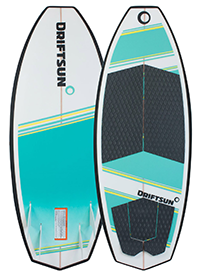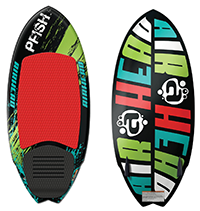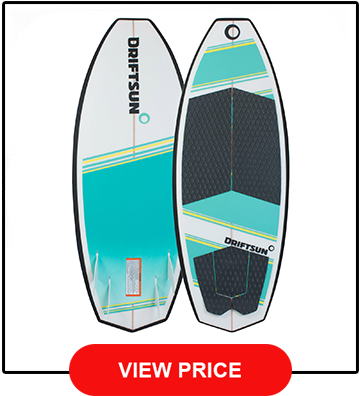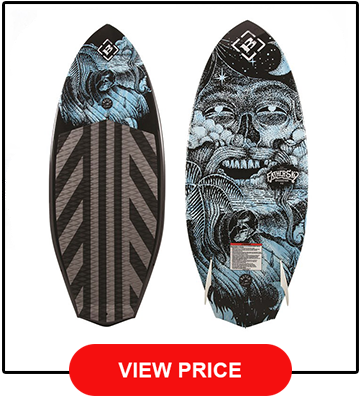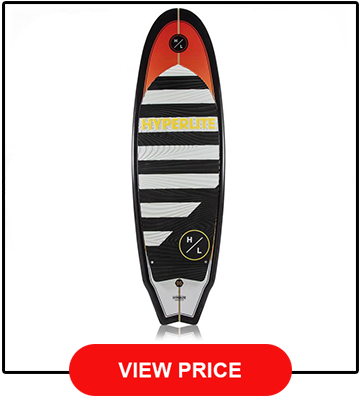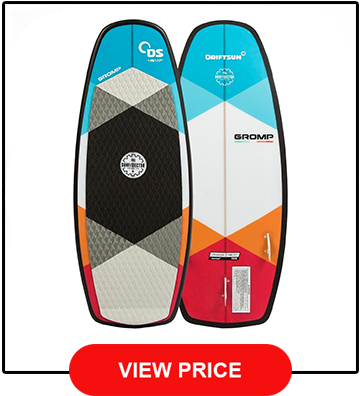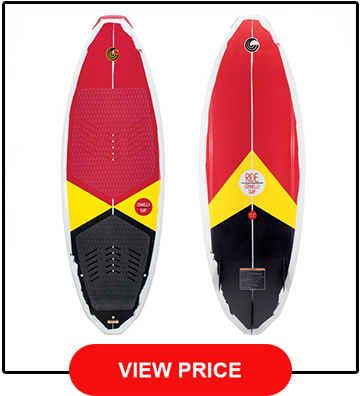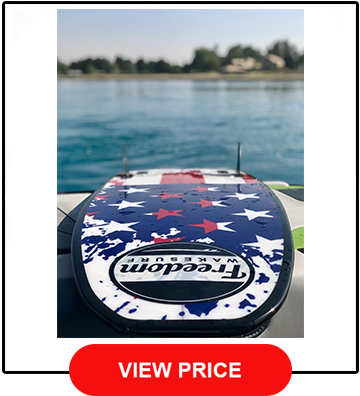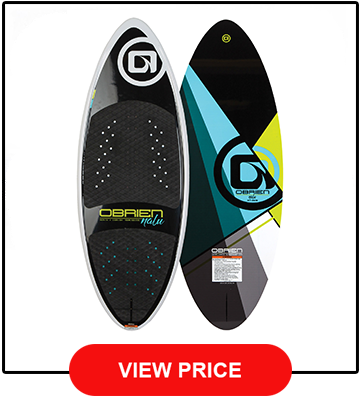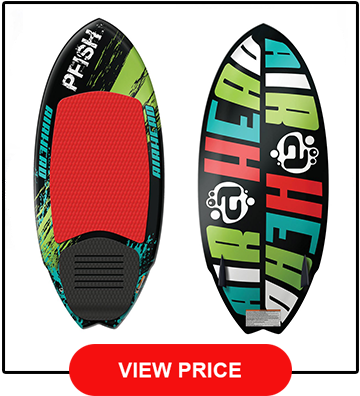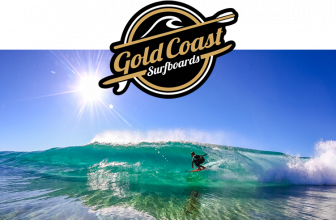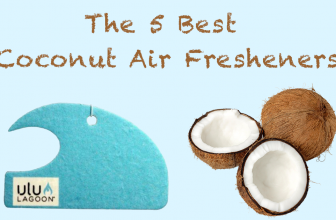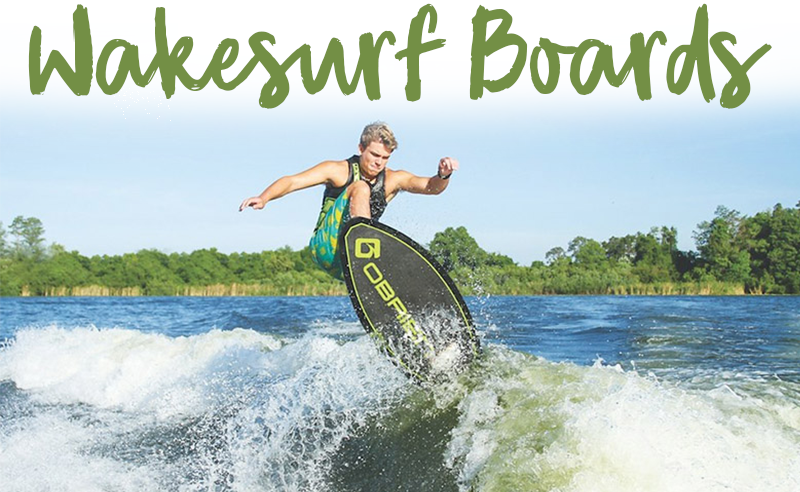
Wakesurfing is different from many watersports as it allows you to continue moving thanks to the wake of the boat.
While it might not be as well as known as surfing or stand up paddleboarding, it is certainly a great sport for those who want to try their hands at a bit of adventure!
More...
Wakesurfing is a bit different than wakeboarding though, as you don't have a rope to tie you to the boat. Instead, you can surf freely around the water.
Because it's such an unknown sport, there is not a lot of information out there on finding the best wakesurf board.
Luckily, we're here to help make the hunt a little bit easier and find you an awesome wakesurf board so that you can get out on the lake ASAP!
Our Favorite Wakesurf Boards
The Top 8
#1 BEST OVERALL: DRIFTSUN THROWDOWN 4’8”
The Driftsun Throwdown 4'8" is the perfect wakesurf board for beginner and intermediate riders alike! Many advanced riders say they love this board too, as it gives them the ability to customize the fin setup. This custom shaped board is made with an EPS core and a natural wood stringer, then hand finished with epoxy and layered with tough fiberglass. It's a board that will hold up to the wildest of the surf. It even comes with an EVA traction pad and kicktail for extra stability and trick possibilities.
While it comes with a Futures F4 quad fin set up, it is completely interchangeable if you’re going for a more customized feel. This is perfect for advanced riders who might want to add a bit of extra speed to their ride. The dual concave base and rocker line allow for a ride that is both quick and responsive, while the low rail and rolled edges give you tons of stability. There are not many boards out there that you can truly grow with, and that’s why we believe the Driftsun Throwdown is one of the best around.
Pro's
Con's
BYERLY 2018 HYPERLITE
Right off the bat, your eyes will be drawn to wizard-like design on this bad boy. Once you ride it, you'll feel the magic inside. This board is compression molded for extreme durability, which also allows for an incredibly responsive ride. There are five possible fin arrangements on this board so that you can mix and match for a customized ride. Beginners and advanced riders alike are in love with this board, as that customization can help suit just about any riding preference or type of water condition.
The layered glass construction and biolite 3 core give this board outstanding durability without compromising any of the actual performance. The traction pad moves along the entire length of the board, except the nose, providing more than enough stability, especially if you’re a beginner rider. For one of the most progressive boards in the industry, look no further than the Byerly 2018 Hyperlite.
Pro's
Con's
HYPERLITE LANDLOCK WAKESURFER
The Hyperlite Landlock Wakesurfer is one of the best wakesurf boards out there for beginners. Thanks to the large volume, the board gives riders tons of stability for easy riding. The stock tri-fin setup allows riders to stay in the pocket without compromising speed. The Landlock is made with a lightweight EPS core and a Monocoque construction. This unique Monocoque construction integrates the top glass and bottom glass into one so that they are more durable. It helps to prevent damage from side impacts, as well as delamination.
The Hyperlite Landlock also uses a unique layered glass, that unlike traditional woven glass fibers, which end up separating over time, will remain intact over time. Even after years of use, your pop will stay the same! If you're looking for one of the best beginner fish-shaped boards on the market, you'll love the Hyperlite Landlock.
Pro's
Con's
DRIFTSUN GROMP
The Driftsun Gromp is one of the best wakesurf boards around for kids. Thanks to the 3'9" build, it is the perfect size for little ones to shred with. The Gromp is made with an EPS Core and a natural wood stringer for a lightweight, yet durable construction. The board is then custom shaped, and hand finished with epoxy and layered fiberglass for a classic feel. Little riders dig the full EVA traction pad that runs along the length of the board, as it helps to provide better balance, especially for those who are still working on their footwork.
The FCS style boxes allow for thruster or twin fin configuration based on the ride you are looking for. It comes with 1.5" DS hook fins for you to get started too. The slight concave base and smooth rocker line give you a fast, yet responsive ride, while the soft rails give you tons of stability as you become more and more comfortable with riding. Because of the small, maneuverable size, you'll be able to perform tricks as you get better.
Pro's
Con's
CONNELLY RIDE WAKESURF BOARD
The Connelly Ride Wakesurf Board is another excellent wakesurf boards for those who are just getting into the game. If you're hopping on the wake for the first time, you'll love how easy this board is to ride. It comes complete with three 1.75" removable tail fins that give you the option to customize as you grow. This is great, as advanced riders typically like to move down to two side fins or one single center fin. The double-edged rails on this board give you a little bit of extra cut into the wake for a bit more confidence when maneuvering.
As much of a beginner board as this is, they didn't skimp out on durability. This board utilizes tough, compression construction and a polyurethane resin around the lightweight, 2-piece core. For kids and adults alike, if you're learning to ride, the Connelly Ride Wakesurf Board is a great one to look at.
Pro's
Con's
Freedom Wakesurf Board
For those are looking to shred, the Freedom Wakesurf Board is fantastic. It's low rail and rolled edges give you tons of stability, helping you to stay up and balanced easier so that you can perform all those wild tricks you've been working on. The Freedom's ride is both fast and responsive thanks to the dual concave bass and rocker line. You can easily pop off the wake to catch some serious air and perform tricks before landing softly back on the water.
The Freedom Wakesurf board is one that you can grow your skills on. At 56” in length, beginners will be able to excel thanks to the sheer volume, while advanced riders will dig the fact that it’s so explosively maneuverable. It comes equipped with an F4 quad fin setup so that you can easily customize your board to change the responsiveness to your taste. All of this pro-ride feel is built into a board with layered fiberglass and an EPS core with hard-finished epoxy and a natural wood stringer. In layman’s terms, it’s a durable and lightweight board that will shred with you until the end.
Pro's
Con's
O’BRIEN NALU WAKESURFER
This compression molded board is no doubt a board for veteran wakesurfers, and it can provide some pretty unique riding. It is made with a durable, epoxy construction and a lightweight feather core. The rocker profile helps to generate next to effortless speed, as the flat surface has been extended a little further into the nose. Planing across the water has never felt more comfortable.
The O'Brien Nalu comes with a single fin that helps to reduce drag, giving you a feel that is much looser overall. It turns nice and tight in the pocket while still producing a substantial amount of drive as you cruise down the wake. O'Brien has always been about making boards that are easy and comfortable to ride while allowing for versatility. The Nalu is a top-of-the-line board with some serious ridability.
Pro's
Con's
#1 BEST FOR BEGINNERS: AIRHEAD PFISH
The Airhead Pfish is one of the best beginner wakesurf boards around, as well as one of the most affordable. The full shape and fish tail setup make it more than forgiving, allowing beginners to ride comfortably as they learn how to glide along the water. As you become more advanced, you'll find that the stability allows getting air with ease, which in turn will enable you to bust out tricks.
It comes complete with a thick, EVA deck and a massive kicker that gives you a solid foothold to start with. This can be especially helpful when you try to get your feet planted in the beginning. Many riders say that they were able to bust out reverses and airs in no time!
Pro's
Con's
How To Choose The Best Wakesurf Board
STYLE
It is essential to understand that there are a few very distinct types of wakesurf boards out there. To make the most out of your riding, you'll want to get the right type of board for your style. Here are the most popular types of wakesurf boards that you'll see on the market:
Surf-Style
While surf-style boards are typically ridden by those who are just getting started, advanced riders are also major fans of these types of boards. A lot of this has to do with the fact that they feel much like surfboards when ridden. The mechanics are very similar to catching larger waves out in the open ocean. You can ride surf-style boards at fast speeds while still being able to maneuver quickly.
Skim-Style
If you're an expert rider, you'll most likely want to get your hands on a skim-style wakesurf board. They're much thinner and lighter in weight compared to most wakesurf boards, making them perfect for popping up and doing airs and tricks. While they are more challenging to ride for beginners, they allow for serious shredding progression. If you've ever watched pro wakesurf competitions, you'll notice that most of these guys use skim-style boards.
Hybrid
Many newer companies are coming out with hybrid boards that help to combine the best characteristics of the surf and skim-style boards, allowing for effortless riding, as well as versatile maneuverability.
Rocker
If you have ever tried out regular surfing before, you know how vital the rocker can be to the feel of your board. The rocker is essentially the amount of curve that your board has when you look at it from the side. The prominence of the curve will have a significant impact on the overall performance. Boards with flatter rockers, otherwise known as continuous rockers, sit flatter on the water and are better for planing and picking up speeds, though it might be hard to get your balance on. Boards with prominent rockers are far more stable and easier to turn, though will be slower.
Fins
The fin setup on a board is often overlooked, even though it plays a significant role in how your board feels. This is why many newer boards utilize customizable fin setups with overall tougher and higher-end fins. Just like with surfboards, wakesurf companies are using tool-less fin systems and carbon fins for better performance. Because there is a such a big emphasis on fin setup, it is essential to understand how different fin setups can affect your board's feel.
Single Fin
The single fin setup is one of the most popular when it comes to skim-style boards, although more and more manufacturers seem to be putting them on their surf-style boards too. These single fins offer tons of stability and hold, though also allow for tricks and spins thanks to their free-breaking design. For medium and large waves, the single fin is the best around.
Twin Fin
If you're looking for a feel that is bit more fun and playful, we would recommend checking out boards that come with a twin fin setup. Twin fins allow for a solid hold on your turns while still giving you the ability to perform tricks and spins. You'll typically find that most surf or hybrid-style boards come with twin fin setups as their stock, though most can be upgraded to three or four. If your setup does come with three, take out the center and feel the difference in those turns. Twins are perfect for just about any wave conditions!
Thruster
The thruster setup, otherwise known as three-fin setup, is easily the most popular type of fin setup in the sport. This is why most wakesurf boards will come with three fins in their stock
setup. The two fins on the outside are there to help generate speed as you move down the line while the center fin is there to provide control and stability. The beauty of a thruster setup is that you can also choose to remove specific fins to get a different feel. For almost any kinds of wave conditions, you can expect the thruster setup to excel.
Quad
You'll only ever find quad fin setups on surf-style boards. If you're looking for a bit of extra speed and pump while riding, then you'll dig the quad feel. The great thing about quad setups is they are very easy to transform into twins if you ever want that looser feel. Quad setups are best ridden on larger waves.
Five Fin
Five fin setups are only ever found on surf-style boards, and while they are not very common, they’re great because they give you tons of versatility, basically allowing you to mix and match fin combinations. While five fin setups can help provide an unreal amount of stability, they also cause a ton of drag. This is why we would never recommend trying to ride with all five fins at one time.
Flex
The flex is the amount of flexibility that your board has. If your board has more flex than not, you'll be able to pop up higher when getting air. More flex also helps with carving on the side of the wave. Having a ton of flex might even make your board a bit less stable, so it is up to you on what feels better. We recommend testing different flex types out if you can, as it more comes down to preference than anything.
Tail
The tail is another crucial thing to consider when looking at the characteristics of your wakesurf board. It will affect how balanced your board is, as well as how you can maneuver on the water.
Square Tail
Square tails are best if you’re looking for pure speed. More than other tails, square tails sit higher up out of the water, allowing you to plane nicely and get up to higher speeds quickly. The biggest issue with square tails is that you may have a harder time getting your foothold down or keeping traction on the water, so do keep that in mind.
Pin Tail
The pintail, as you might have guessed from the name, is one of the thinnest tails around. It's excellent for wakesurf riders who want to challenge bigger wakes. These pin tails dip into the water more easily, allowing you to get the lowest center of gravity. While having that grip may be great for large wakes, it can cause speed issues as the wakes get smaller.
Swallow Tail
The swallowtail has the best of both worlds and is a bit of a hybrid between the square tail and pintail. That's probably why it's one of the more popular choices for average riders. Thanks to the easy-to-control design and lift that allows for speed, it's pretty good for riding wakes that are moderate.
Round Tail
If you're planning on wakesurfing in different water conditions, we would highly recommend going for a board with a round tail. The design of the round tail makes it function a lot like a pintail, though it has a lot more surface area, making it easier to balance and pick up speed on. Round tails are especially great if you're looking to perform easy turns and tricks.
Squash Tail
Squash tails are easily the most widely used tails on the market right now thanks to their versatility and ability to function well in a variety of wave conditions. Whether the wake is small and mushy or steep and powerful, the squash tail should be good to go. Beginners will love the added stability of a squash tail, and veteran riders will dig the speed.
Half Moon Tail
This is probably the least popular type of tail out there, as it is more used for specialty reasons. The half-moon cuts out most of the surface area behind the fins, allowing the rider to do tricks and turns without having the tail get in the way as much. The great thing about half moon tails is that they are super easy to maneuver in pretty much any wave conditions.
Diamond Tail
Diamond tails are somewhat of a hybrid between squash tails and pintails. They offer a pretty good amount of speed while still being pretty easy to maneuver. For those who are looking for an easier, smoother ride, though still want the ability to bust out some tricks, we recommend the diamond tail. It is great for beginners and advanced riders alike!
Bat Tail
The Bat Tail is another type of specialty see that we don’t often see in wakesurf boards. The tail has a bat-like aesthetic, hence the name, and is incredibly wide, giving riders extra stability on the water. The cool thing is, the added corners of the tail help it to slice through the water, making it easy to maneuver as well.
Rail
The rail will have a major effect on how water moves around your wakesurf board. More than anything, the rail will define how you can ride in and out of turns. A rail that is thicker and rounder will provide a more stable and balanced feel while a thinner and sharper tail will give you more speed and responsiveness on your turns. There are a few different types of rails out there that you should keep an eye out for, each with their advantages and disadvantages.
Full Rail
If you’re looking at a surf-style board, it is likely that it has full rails. These are best for beginner riders, as they provide both consistency and stability during turns. Fuller rails are made to hold on to the rails and the waves, creating a bit of a pathway to help sustain speed and direction as you move forward.
Hard Rail
If you’re looking at a skim-style board, it is likely that it has hard rails. These harder rails are built with thinner, harder edges that cut through the water. While you still get a good amount of speed with hard rails, they are best for breaking free and hitting spins or tricks. Hard rails are best for intermediate or advanced riders, as they have a much looser feel that requires more balance from the rider.
Blended Rail
As you might have guessed, the blended rail is a blend between a full and hard rail design. These blended rails are mostly found on hybrid-style boards, and they're pretty much a great option for any rider. They have the stability of full rails, though allow for breaking when it comes to tricks and turns.
Size
The bigger the board, the easier it will be to maintain direction and stability. This is why we recommend beginners get bigger boards with larger dins. The downside to larger boards is that they will hinder tricks and turns as you go along. The smaller the board, the easier it will be to get into spins and tricks. The downside is, you'll have a lot of trouble maintaining balance, especially if you're starting.
Must-Have Wakesurf Accessories
So by now, you should have a pretty good understanding of what type of wakesurf board works best for you. Once you have your board in hand, it is time to start looking at some must-have accessories to pair with it. Here are some accessories we think are necessary for a bona fide wakesurfing experience.
Wakesurf Ropes
You can't just use any old rope for wakesurfing. It is important that you get a wakesurfing rope if you want to be safe. Wakesurf ropes will be anywhere between 15 and 25 feet in length, just enough to get you in the best part of the wake. The handles are usually soft and coated with some sort of foam rubber, just large enough to fit one hand inside. The size is safe, as it stops other body parts from getting caught and dragged.
The main things to consider when it comes to buying a wakesurf rope is comfort and length (maybe color if you care). Other than that, they're only meant to get you out of the water so that anything will do!
Wakesurf Bag or Sleeve
When you start getting into the world of high-performance wakesurf boards, you'll begin to realize just how fragile these boards are. Even though they are built to perform at crazy levels, doing tricks and turns and speeding across waves, they are still very vulnerable to cracks, dings, and delamination. This is why it is of the utmost importance to get a sleeve or bag to help protect your board. You don't have to spend an arm and a leg on one, though make sure that whatever protective cover you get, it has ample padding and sun protection. Here are the pros and cons of each:
The main downside to Board bags is that they are typically more expensive, though they are better for protecting against the harmfulness of UV rays and accidental falls. They will usually come with handles or shoulder straps, so they are easier to carry around, especially when you have other gear. The cool thing is, board bags usually come with extra pockets to store away your accessories like fins, boards shorts, and whatever else you might need to bring along. If you're traveling or flying a lot, we would highly recommend getting a board bag.
The main downside to a board sleeve is that there is less protection and storage. Even with that said, board sleeves still offer a solid amount of protection from the sun, and they are an excellent option when you're looking for a quick and painless way to transport your board. They're also excellent if you only need a way to store your board away safely.
FAQ
How To Wakesurf
As with anything, getting started is the hardest part. We’re hoping that this little step-by-step can get you out on the wake with ease. Before anything, you need to figure out your stance. This is especially important if you’ve never done any board sports before. If you’re Regular, you’ll have your left foot in front, and if you’re Goofy, you’ll have your right foot in front. Once you’ve got that down, you’re good to go.
Getting Set Up
When you first set yourself up behind the boat, you’ll want to do so at a 45-degree angle. The reason being is because you want the wake to build up behind you so you can continue moving into it as it builds. If you start directly behind the boat, the wake will build directly into you, forcing you to surf down on it.
Get Your Footing Right
By now you should be at a 45-degree angle to the back of the boat. Position your feet just shoulder width on the board, or whatever you feel comfortable with. Your heels should be flat on the board with your toes directed towards the sky. Keep your heels fairly close to the edge of the board, as it will help you flip on your feet more easily. At this point, your body should be in somewhat of a cannonball position with your knees bent and your chest inward. Keep in mind that all of this should be done before the boat moves out of the neutral position.
Getting Up
The driver needs to have a bit of experience here as well, as they are just as much responsible for getting this right. As the driver starts moving the boat forward slightly and the line gets tight, push your heels straight down and keep your toes pointing toward the sky. Once you're up on your heels, holler to the driver to kick it into high gear.
Moving Into the Wave
By this point, you’ve made it up! The hard part is over. Now you need to find your balance. Your weight should be about 50/50 on each foot most of the time as you start to get your bearings down. For now, try and stay at the bottom of the wave.
The Roles Of Your Feet
It’s best to think of your front foot as the gas pedal and your back foot as the brake pedal. If you want to speed up on the wave, put a bit more pressure on your front foot. If you want to back off a little bit, put a bit of pressure on your back foot. This pressure doesn’t have to be anything crazy as you’ll see. Even the smallest of movements make a pretty big difference. Whatever you do, you’ll want to make sure that you are holding onto the rope with your front-facing hand.
Find Your Sweet Spot
Once you have your footing figured out, you must find the sweet spot of the wake so that you can stay up. The sweet spot is typically right in the middle. If you go too high, the wake will push you back. If you go too low, the wake will suck you under. Once you've found your sweet spot and you're confident, throw the rope into the person on the back of the boat. Make sure that they pull it in all the way so that you don't get caught. You're now wakesurfing! Keep it balanced and once you get the hang of everything, try busting out a few tricks.
How Do I Clean My Wakesurf Board?
Your wakesurf board should have a solid cleaning every time you leave the water. You don’t need to do anything crazy here, as even a small bit of fresh, warm water will do. Fresh water helps to remove salt, dirt, and grime from your board that may have stuck on after you left the water. Make sure that you leave your board out to dry before putting it back in storage, as it might attract mold and mildew if not.
Final Thoughts - Which Should You Get?
Getting the right wakesurf board requires a lot of research! This is because there are so many different types of wakesurf boards with a variety of accessories and features that make them so different from one another. If there is one thing we can leave you with, it would be to get the right style board for your experience. Beginners should start with surf-style boards, and intermediate or experienced riders should get skim or hybrid-style models.
Overall, we love the Driftsun Throwdown 4’8”. It has a mix of awesome features that make it an excellent board for beginners and experts alike.
We hope that our reviews and guide were helpful in finding the right wakesurf board for your needs! Wake on!

